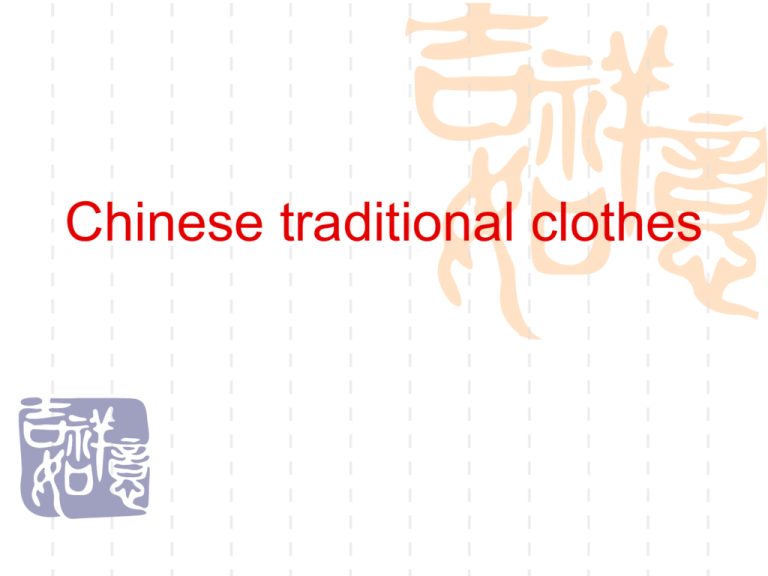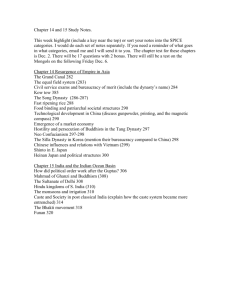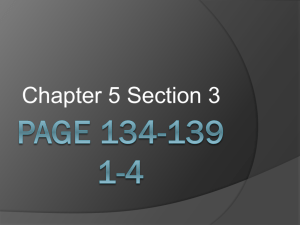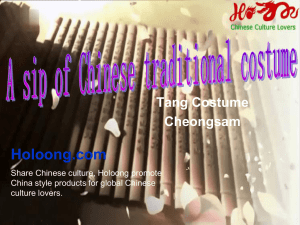Chinese traditional clothes
advertisement

Chinese traditional clothes Costume in the Han Dynasty Costume in Tang Dynasty Chinese Cheongsam Costume in the Han Dynasty China's complete code of costume and trappings was established in the Han Dynasty (206BC-220AD). The yarndyeing, embroidering and metalprocessing technologies developed rapidly in the period, spurring changes in costume and adornments. The costume code of the Western Han Dynasty (206BC-8AD) followed the one established in the Qin Dynasty (221-206 BC). In the Eastern Han Dynasty, people in black had to wear purple silk adornments to match their clothes. People usually wore costume with a long hat at grand ceremonies offering sacrifices to gods or ancestors. The dress of the queen in these ceremonies consisted of dark-purple frock and black trousers. The silk dress of the queen consisted of cyan frock and buff trousers. Costumes of the Han Dynasty had 7 features: 1. Wearers must expose underwear' collar form , as the collar was big and curving; 2. Clothes must use white cloth as lining; 3. The width of sleeve was 0.4 meters; 4. The blouse had no sleeve; 5. Wearers of fur clothes should have the fur facing outside; 6. Waistband was very exquisite. Belt hook was made of gold in various lively and interesting animal figures; 7. The male kept the habituation of wearing walking sabres without blades for decoration only. • Costume in the Tang Dynasty The unified and prosperous China was established in the Tang Dynasty (618-907). In China's history, the Tang Dynasty was a period when the politics and economy were highly developed and the culture and art were thriving. The clothing materials were exquisite, the structure was natural, graceful and elegant, and adornments were splendid. 15 Women's dress and personal adornments of the Tang Dynasty were outstanding in China's history. In this way, a special open and romantic style of dress and personal adornments was formed. It was a fashion for women to wear Hufu (garments of the Tartars or those who lived in the Western Regions). After the High Tang, the influences of Hufu were gradually weakened and women's garments became broad and loose day by day. As to ordinary women's garments, the width of sleeve was always more than 1.3 meters. Though the forms of garments were still the continuation of the Han Dynasty (206BC-220AD) and the Sui Dynasty (581-618), they were influenced by cultures and arts of the Western Regions. Especially, the national power of the High Tang was strong. The trades and cultural exchanges with Korea, Japan, Persia and other countries gradually became frequent, and they mutually dispatched emissaries and accepted students of other countries. Chinese Cheongsam The cheongsam, or Qipao in Chinese, is evolved from a kind of ancient clothing of Manchu ethnic minority. In ancient times, it generally referred to long gowns worn by the people of Manchuria, Mongolia. In the early years of the Qing Dynasty (16441911), long gowns featured collarless, narrow sleeves in the shape of a horse's hoof, buttons down the left front, four slits and a fitting waist. Wearers usually coiled up their cuff, and put it down when hunting or battling to cover the back of hand. In winter, the cuff could serve to prevent cold. The gown had four slits, with one on the left, right, front and back, which reached the knees. It was fitted to the body and rather warm. Fastened with a waistband, the long gown could hold solid food and utensils when people went out hunting. When the early Manchu rulers came to China proper, they moved their capital to Beijing and cheongsam began to spread in the Central Plains. The Qing Dynasty unified China, and unified the nationwide costume as well. At that time, men wore a long gown and a mandarin jacket over the gown, while women wore cheongsam. Although the 1911 Revolution toppled the rule of the Qing (Manchu) Dynasty, the female dress survived the political change and, with succeeding improvements, has become the traditional dress for Chinese women. Till the 1930s, Manchu people, no matter male or female, all wore loose-fitting and straight-bottomed broad-sleeved long gowns with a wide front. The lower hem of women's cheongsam reached the calves with embroidered flower patterns on it, while that of men's cheongsam reached the ankles and had no decorative patterns. After the 1940s, influenced by new fashion home and abroad, Manchu men's cheongsam was phased out, while women's cheongsam became narrowsleeved and fitted to the waist and had a relatively loose hip part, and its lower hem reached the ankles. Then there emerge various forms of cheongsams we see today that emphasize color decoration and set off the beauty of the female shape. 28 Why do Han people like to wear the cheongsam? The main reason is that it fits well the female Chinese figure, has simple lines and looks elegant. What's more, it is suitable for wearing in all seasons by old and young. 31








